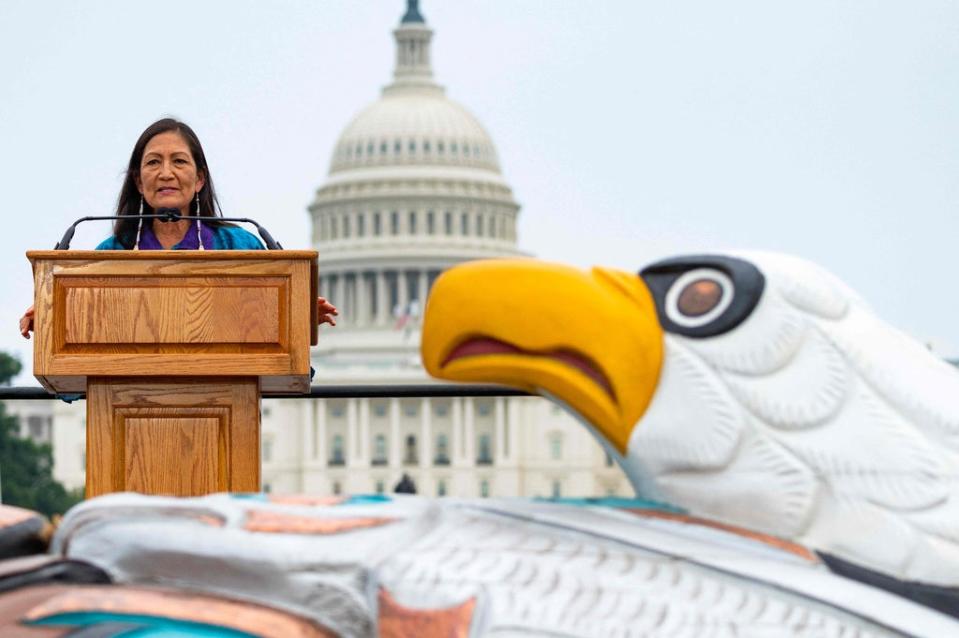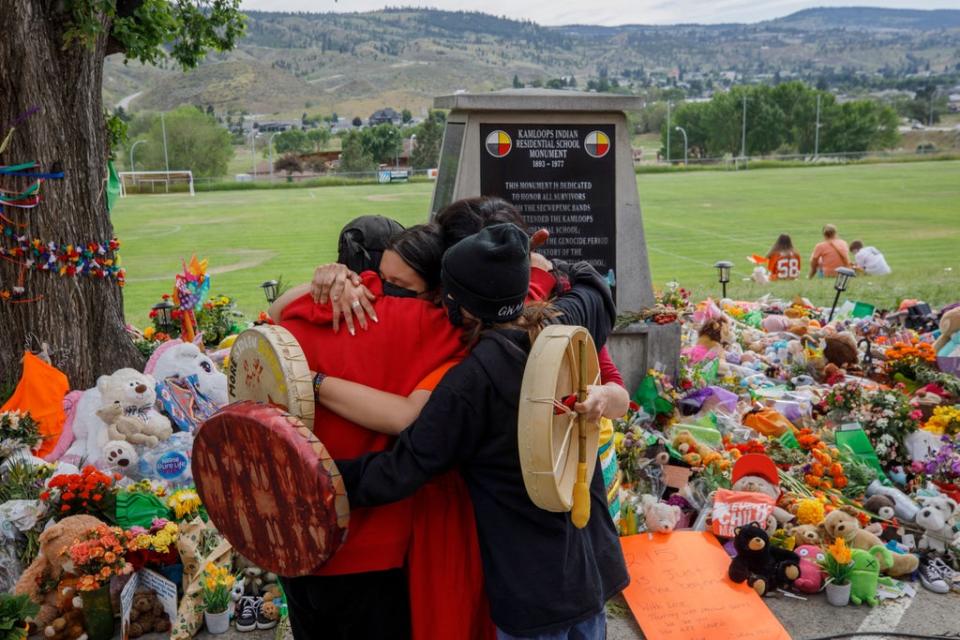From typhoid to boxing deaths: Inside a government-run Native American assimilation school
Researchers have uncovered “indications of neglect and abuse” as they identify increasing numbers of children who died at one of the largest Native American assimilation schools in the country – which operated under the philosophy of “kill the Indian, save the man.”
So far, at least 90 students were found to have died at the Genoa US Indian Industrial School, located about two hours west of Omaha, Nebraska. Operating between 1884 and 1934, it taught thousands of children from over 40 Native American nations. At its peak, 600 pupils were enrolled at once at the institution, which was designed to strip children of their culture and beliefs, convert them to Christianity and essentially whitewash their lives.
Of the 90 students who died while at Genoa, researchers have discovered more than 50 of their names – and the true death toll is likely much higher as the search continues for their burial places.
“If you read accounts or listen to accounts by survivors of the boarding schools, they talk a lot about the really harsh punishments ... and we have come across some causes of death that include drownings, accidents including a child being hit by a freight train, accidental shootings,” Margaret Jacobs, co-director of the Genoa Indian School Digital Reconciliation Project and professor of history at the University of Nebraska-Lincoln, tells The Independent. “Why would there be a gun at an Indian school?
“Sports were really big in the schools, and we’ve got a couple of accounts that talk about a child that was boxing and died shortly after a boxing match. There is evidence of that kind of negligence.
“There were a lot of runaways, and if they were caught and brought back, they could expect very harsh punishments ... These were really brutal institutions. I do think the number [of dead] is likely to be higher.”
The local Nebraska community has spent decades attempting to honour and preserve the legacy of the students, all of whom are now believed to be deceased. The Genoa US Indian School Foundation is a nonprofit that was founded in 1990, and in 2018 the Reconciliation Project began gathering records to better document what went on at the institution.
It was the Project which uncovered the names of the dead using documents such as newspaper archives, including student publications from the Genoa school itself. Official government records have yet to be found and the names on that list won’t be published until tribal leaders are consulted and an attempt to contact relatives of the dead is made.
“We do think we’re going to find more, because we’re just going to keep combing through these government reports, medical statistics that they kept to see what we can find for every year,” Prof Jacobs tells The Independent. “So we believe our goal is to at least get an overall count and then to try to find as many of the names of the children as possible.”

Sickness was another huge cause of death at the school, Prof Jacobs says. Of 25 federally-run boarding schools in one system, the Genoa Indian Industrial was among the largest.
“The administrators talked about it a lot – how there were various diseases, whether it was tuberculosis, diphtheria, typhoid, flu. They would sweep through the schools, and the schools were overcrowded, and they were pretty unsanitary,” she says.
“Ironically, often authorities talked about taking children away from their communities because they said their communities were too impoverished or too poor or there was bad healthcare ... and then they’re putting them in these overcrowded schools where they’re subjecting them to the likelihood of being infected with these really contagious diseases.”
She adds that researchers have found evidence that officials sent children deemed “incurable” home to die. That could be viewed as a compassionate move – or an attempt to keep down numbers of school deaths, she notes.
“These authorities were counting students but rarely actually writing about them and putting their names down. And we’re hoping to find a registry of deaths; so far, we haven’t found that. We’re hoping to find letters from school administrators to parents about their children. We’ve only found a few of those, so most times, this just doesn’t seem to be making it into the government record.”
When the school closed, documents were either destroyed or scattered across the country. Locating them has been challenging for both the Genoa project and others working to gather information on the schools.
“It’s very frustrating and it’s heartbreaking, because the whole point of our project is to repatriate these records to native communities and to honour the history and honour the experience of what Native families have endured through the boarding school experience,” Prof Jacobs tells The Independent.
“We’re hoping this is a healing project by returning knowledge to tribal nations about their people, but how healing can it be if they are finding more and more of their children who died and authorities treated them in such a callous manner?” she says.
That attempt to facilitate healing, however, includes locating the children’s final resting places. Researchers have found many references - both in documents and recorded accounts - to a cemetery on school grounds, and the Nebraska Commission on Indian Affairs is working with the State Archeology Office to find it, the Omaha World-Herald reported.
Searchers are using a 1920 map and employing ground-penetrating radar but have so far been unsuccessful, Judi gaiashkibos, executive director of the commission, told the newspaper.

“I think America needs to take these little children back home, and if we’re not able to find them, I think we need to do something to recognize that they lost their lives there,” said Ms gaiashkibos, a citizen of the Ponca Tribe whose mother attended the school but said little about the experience.
“I have a lot of feelings, a lot of mixed feelings,” Ms gaiashkibos said. “As a country, I think there was a collective decision that this isn’t the history that we want to tell. That the truth is too painful to reveal.
“I think it’s time to take responsibility for that, and to do something positive for the future.”
The truth behind – and hiding of – the realities at Genoa are hardly limited to Nebraska; earlier this year, the remains of more than 200 children were found on the site of what was Canada’s largest indigenous residential school.
Prime Minister Justin Trudeau said in May that he was “appalled by the shameful policy that stole Indigenous children from their communities.
“Sadly, this is not an exception or an isolated incident,″ he said. ’’We’re not going to hide from that. We have to acknowledge the truth. Residential schools were a reality — a tragedy that existed here, in our country, and we have to own up to it. Kids were taken from their families, returned damaged or not returned at all.”
One month later, US Interior Secretary Deb Haaland – a member of Labuna Pueblo and the first Native American to serve as a Cabinet secretary, announced an official review to “uncover the truth about the loss of human life and the lasting consequences” of policies that over the decades forced hundreds of thousands of children from their families and communities.
“To address the intergenerational impact of Indian boarding schools and to promote spiritual and emotional healing in our communities, we must shed light on the unspoken traumas of the past no matter how hard it will be,” Secretary Haaland said.
Earlier this month, Prof Jacobs held a talk in Lincoln about the Genoa school that attracted an audience of more than 80, both Native and non-Native, where “people took it very seriously,” she tells The Independent.
“It’s very moving for people to actually go to the location of the school and wander through the halls and kind of just imagine what their ancestors and relatives went through,” she says. “I actually kind of compare it to my experience going to Buchenwald. There’s this sense of being haunted.
“I’m not a Native person, but I think it’s just so important to tell this story and to [use] my skills as a scholar to shine a light on this and support indigenous activists and advocates who are trying to bring this history to light and to find a way to heal from it,” she says.
“The reaction has been great interest right now in Nebraska and kind of a very sombre concern with this - and I think a lot of people are finally kind of getting the gravity of these schools.”
Read More
Review: A hider of people is hunted in 'Left-Handed Twin'
US: oil, gas leases on hold around New Mexico's Chaco park
For Nebraska Rep. Fortenberry, a two-sided challenge in 2022
102 Native American children died at government-run Nebraska school
University of Maryland to create five new cultural centres
Program to kill Grand Canyon bison nets 4 animals, criticism

